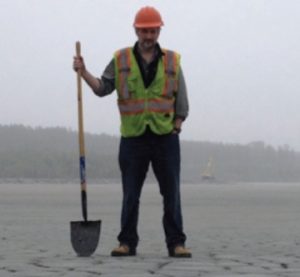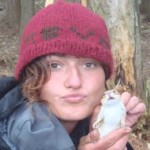 Sean Thomas (PhD Harvard, 1993) is the lab Principle Investigator, and has been preoccupied with the comparative biology of trees and forest responses to the intentional and accidental impacts of humans for some 25 years. Sean is currently appointed as an NSERC Industrial Research Chair in Biochar and Ecosystem Restoration.
Sean Thomas (PhD Harvard, 1993) is the lab Principle Investigator, and has been preoccupied with the comparative biology of trees and forest responses to the intentional and accidental impacts of humans for some 25 years. Sean is currently appointed as an NSERC Industrial Research Chair in Biochar and Ecosystem Restoration.
Research in the Thomas lab addresses how trees and forests respond to human impacts, and how forest management can enhance ecosystem “services” (things people want from forests), ranging from biodiversity to carbon sequestration and climate mitigation. Recent research has taken a turn to the “dark side” of forest ecology – namely biochar (or charcoal used as soil amendment). We are currently exploring many aspects and applications of biochar, including its use for remediation of contaminated substrates such as mine tailings, its use as a soil amendment in N-saturated forest ecosystems, and biochar from the perspective of emulating natural fire disturbance (“fire without the burning”).
Lab publications:
Current Lab Members and Current Projects
 Jillian Bieser is a PhD student working on harvest impacts on soil greenhouse gas fluxes in boreal forests, and the potential use of biochars for mitigation.
Jillian Bieser is a PhD student working on harvest impacts on soil greenhouse gas fluxes in boreal forests, and the potential use of biochars for mitigation.
 Susan Frye is a PhD student working on the biology of bees in Ontario forests and effects of honeybee introduction on native bees in forest ecosystems.
Susan Frye is a PhD student working on the biology of bees in Ontario forests and effects of honeybee introduction on native bees in forest ecosystems.
 Nigel Gale is a PhD student working on plant growth and physiological responses to biochar in the context of ecological resotration.
Nigel Gale is a PhD student working on plant growth and physiological responses to biochar in the context of ecological resotration.
 Sossina Gezahegn is a PhD student working on the chemical and physical properties of biochars generated from Canadian wood species for purposes of making “designer biochars”
Sossina Gezahegn is a PhD student working on the chemical and physical properties of biochars generated from Canadian wood species for purposes of making “designer biochars”
 Adam Gorgolewski is a PhD student working on methane emissions from dead wood.
Adam Gorgolewski is a PhD student working on methane emissions from dead wood.
 Md. Abdul Halim is a PhD student working on climate feedbacks involved with boreal forest disturbance, including radiation balance and soil greenhouse gas flux.
Md. Abdul Halim is a PhD student working on climate feedbacks involved with boreal forest disturbance, including radiation balance and soil greenhouse gas flux.
 Pedro Guayasamin is a PhD student working on effects of charcoal on tropical soil invertebrates, with a focus on current biochar amendments and “terra preta” in the Amazonia region of Ecuador.
Pedro Guayasamin is a PhD student working on effects of charcoal on tropical soil invertebrates, with a focus on current biochar amendments and “terra preta” in the Amazonia region of Ecuador.
 Katerina Kostyukova (co-supervised, Jay Malcolm) is a PhD student working on the spatial ecology and habitat preferences of small mammals in Central Ontario.
Katerina Kostyukova (co-supervised, Jay Malcolm) is a PhD student working on the spatial ecology and habitat preferences of small mammals in Central Ontario.
 Janani Sivarajah (co-suprevised, Sandy Smith) is a PhD student working on the comparative ecology of UV penetratration through tree leaves and canopies in the context of urban forestry.
Janani Sivarajah (co-suprevised, Sandy Smith) is a PhD student working on the comparative ecology of UV penetratration through tree leaves and canopies in the context of urban forestry.
 Juliana Vantellingen is a PhD student working on variation in soil greenhouse gas fluxes in relation to tree species and ontogeny.
Juliana Vantellingen is a PhD student working on variation in soil greenhouse gas fluxes in relation to tree species and ontogeny.
To prospective students:
The short answer is YES, I am seeking highly motivated, knowledgeable, clever, and hard-working graduate students interested in forest ecology and ecophysiology. Work in the lab includes both applied and “basic” research in tropical, temperate, and boreal systems. Support for graduate studies is available on a competitive basis for both international and Canadian students (though more opportunities exist for the latter). In order to be competitive for admission and financial support you will need to present very strong academic credentials. A good match with a potential graduate advisor is also critical.
My main areas of research interest include applied forest ecology and silviculture, comparative ecology and ecophysiology of trees, forest canopy biology; ecological aspects of global environmental change, and tropical forests. The following topics are planned as the main focus of research in my lab over the next 4-5 years:
- “Biochar” use in environmental remediation. Research is planned to examine biochar use for environmental remediation of contaminated soils and in urban forestry. Specific projects under development will examine biochar use on mine tailings, biochar use in industrial brownfields, and biochar to mitigate salt effects on urban tree plantings. In all cases studies will include lab, greenhouse, and field components, and will focus on the development of “designer” biochars for specific remediation purposes. A strong background in soil science and/or chemistry would be desirable for these studies (e.g., physical chemistry of sorption processes, metals bioavailability, physio-chemical characterization of porous materials).
- Spatial ecology of temperate forest systems, and tropical-temperate comparative studies. The lab has recently completed the first mapped forest “mega-plot” in North America, 13.5-ha plot in old-growth forest along a lake margin at Haliburton Forest in central Ontario with ~50,000 trees/plot mapped. The main motivations for the project are to understand the role of aquatic-terrestrial margins on forest diversity and dynamics, to examine relationships between soil factors and tree distributions and growth patterns, and as basis for parameterization and testing of individual-based forest simulation models. We are also specifically examining spatial variation in soil methane flux. The plot has been established in collaboration with the Center for Tropical Forest Science, and will also form the basis for planned large-scale comparative studies of temperate vs. tropical forests.
- Age-related changes in tree functional biology as a driver of belowground and soil processes. Planned experiments will involve measurements of litter decomposition, soil CO2 and methane flux, autotrophic respiration, and fine root dynamics in the rooting zone of trees of varying ages, and will make use of large-scale mapped forest plots in Northern Hardwood forests of central Ontario.
- Leaf optics and remote sensing of tree ageing and ecosystem processes. Planned experiments will involve measurements and analysis of leaf- and canopy-level spectral reflectance and transmittance patterns, and how these vary with tree ontogeny. In addition, the project may involve use of high-resolution LiDAR (Light Detection and Ranging) data as a means of detecting age-related changes in canopy architecture.
Some of the instruments and techniques used in the lab include:
- Leaf and whole-plant gas exchange (Licor Li-6400 system).
- Leaf and canopy optical analysis (Ocean Optics and other systems).
- Chlorophyll fluorescence (Walz miniPAM).
- Soil and woody tissue respiration (Li-6400 with soil chamber).
- Soil and woody tissue methane flux (Los Gatos ultraportable GHG system)
- Mobile canopy lift for canopy access and experimentation.
- Canopy meteorological tower with meteorological instrumentation and eddy flux systems for energy, CO2, and methane flux.
- Hemispherical photograph analysis (digital cameras with fisheye lens; WinScanopy and other software).
- Tree mapping and measurement equipment (Lasertech system, Nikon total station).
- Dendrochronological analysis (TRIM system, WinDendro, CDendro).
- Higher-level statistical software for analysis of large datasets (e.g., R).
- Phylogeny-based comparative analysis techniques.
- Elemental analysis (CN analyzer, Atomic Absorption and ICP spectrometers).
- NOVAe Gas sorption system for surface area and pore size analysis (BET theory and extensions).
- LiDAR and multi/hyper-spectral remote sensing of forest structure and function.
- Empirical modeling of spatial interactions using maximal likelihood methods.
- Use of individual-based, spatially explicit forest simulation models.
- Experimental pyrolysis system.
Special consideration will be given to students with prior experience closely related to these projects and/or methods used; prior natural history background, especially related to work in tropical sites, is also an important factor.
If you think that I would be a good match as a prospective advisor, I will need to evaluate your background and prior work more carefully. What I specifically would need from you is: (1) a note explaining your interests and prospective thesis topic, how this would fit with what the direction of research in my lab (as outline above), and what skills and background you would bring to this effort; (2) a resume and copy of transcripts (or list of prior coursework with marks); (3) a copy of a paper you have written that represents what you consider to be your best scientific work to date.
Lab Alumni
Post-doctoral fellows:
- Ken Arii (PhD McGill, 2003) was a post-doc on the SFMN post-harvest mortality project (2005-2007), and worked on simulation of harvest patterns, model “initialization” problems, and development of project-specific cross-dating tools. Ken is a faculty member an Associate Dean of Academic Affairs of the College of Asia Pacific Studies at Ritsumeikan Asia Pacific University, Japan.
- Dan Bebber (PhD Oxford, 2001) worked in the lab as a post-doc (2002-2003) examining responses of white pine to partial stand harvests in the Algoma region of Ontario. Dan is the head of climate change research for the Earthwatch Institute, UK.
- Michael Drescher (PhD Univ Wageningen, 2003) worked as a post-doc on the Haliburton Forest mega-plot project, examining tree senescence effects on forest dynamics and the spatial dynamics of natural enemy effects. He is currently a faculty member at Waterloo University (webpage).
- Michael Fuller (PhD Univ New Mexico, 2004) was a post-doc involved in forest carbon flux and meteorological work at Haliburton Forest. Mike is interested in spatial processes and analysis of forest communities, and the application of theoretical ecology to applied problems in forestry. He currently teaches at University of New Mexico. (M Fuller’s website)
PhD students:
- Jennifer Baltzer (PhD, 2005) studied physiological aspects of soil habitat preferences in tropical and temperate trees. She went on to do a post doc with the Center for Tropical Forest Science Asia Program at Harvard University, and is now a faculty member at Mount Allison University (webpage).
- Tomasz Gradowski (PhD, 2006) examined responses of canopy trees and understory vegetation to additions of non-nitrogenous nutrient additions at Haliburton forest, documenting pronounced phosphorus limitation in this system. Tomasz works in environmental consulting in British Columbia.
- Trevor Jones (PhD, 2006) investigated growth and physiological responses of trees to selection management harvests in tolerant hardwood forests in Ontario. Since May of 2008, Trevor has worked as the hardwood ecosystem research scientist at the Ontario Forest Research Insitute in Sault St.-Marie, ON.
- Jean-Remy Makana (PhD, 2004) worked on the ecology and sustainable management of African mahoganies in eastern Congo. Jean-Remy is currently a forestry specialist for central Africa employed by the Wildlife Conservation Society, and holds an academic appointment with the University of Kisangani, Dem. Rep. Congo.
- Liz Nelson (PhD 2011) worked on dendrochronological to quantifying effects of anthropogenic climate change on boreal forest growth. She is employed as a science policy analyst for the Canadian Forest Service.
- Rajit Patankar (PhD 2010; co-supervised, Sandy Smith) worked on interactions between canopy-dwelling mites and tree gas-exchange and growth dynamics. He is currently teaching at University of Toronto and in the market for a post-doctoral position.
- Yuan-Ying Peng (PhD, 2007) examined the responses of soil carbon flux to silvicultural interventions, including partial stand harvests and soil amendments. Yuan-Ying is currently teaching environmental science at Triton College in Chicago, USA.
- Hilary Thorpe (PhD 2008; co-supervised, John Caspersen) documented and modeled responses of black spruce ecosystems to partial harvests in the Lake Abitibi Model Forest in northern Ontario. Hilary is currently a post-doc at University of British Columbia, working mainly in Haida Gwaii.
Masters students:
- Michael Bendzhak (MFC, 2004) investigated tree recruitment patterns in red pine plantations at Joker’s Hill Reserve in the Oak Ridges Moraine north of Toronto. Mike works as forest management and renewal coordinator for the Saskatchewn Forest Centre.
- Nat Iwanycki (MFC, 2001) examined responses of the understory vegetation community to selection harvests at Haliburton Forest in central Ontario, and established the first round of permanent sample plots at Haliburton. Nat works as staff terrestrial ecologist for the Toronto Regional Conservation Authority.
- Bea Lucas (MFC, 2006) examined performance of hybrid poplar in mixed vs. monoclonal stands as part of the Forest 2020 program in southern Ontario. Bea is on the staff othe Mediterranean regional office of the European Forest Institute in Barcelona, Spain, where she works on wood product chain assessment.
- Greg Malczewski (MFC, 2005) worked on patterns tree growth and potential carbon sequestration of native species in north-east China. Greg is employed as a Policy Advisor in the Air Policy and Climate Change branch of the Province of Ontario.
- Erin Mycroft (MScF 2010) worked on polypore fungi as agents of tree decline in nothern hardwood forests, and developed molecular methods for characterizing polypore fungal communities in live woody tissue. Erin is currently in teacher’s college, and plans to focus on environmental education at the secondary school level.
- Tyler Peet (MFC, 2007) worked on developing statistical predictors of tree age and recent growth based on gross morphology of sugar maple. Tyler works currently with the BC Ministry of Forests and Range in the Queen Charlotte Islands.
- Megan Saprunoff (co-supervised, John Caspersen; MSc, 2005) studied the light requirements of tree species in the Changbaishan reserve in north-east China. Megan is currently working in Queen Charlotte Islands with Forests British Columbia.
- Jennifer Shuter (MFC, 2002) examined responses of coarse woody debris and the polypore fungi community to selection harvests at Haliburton Forest in central Ontario. Jennifer is completing a PhD in conservation biology at Guelph University.
- Fraser Smith (MScF 2009; co-supervised, John Caspersen) did a project on mortality following structural retention harvesting at the farthest north extension of operational forestry in Canada, in the Yukon Territory. Fraser currently works as an arborist, environmental consultant, and contractor.
- Liora Zimmerman. (MFC, 2003) examined the effects of forest roads on forest structure and tree species composition at Haliburton Forest. Liora works with KBM forestry consultants in Toronto, Ontario.
Haliburton Forest and Wildlife Reserve, Ltd.
![]() Most of the temperate forest research in the lab is conducted at Haliburton Forest, a privately owned area of ~25,000 ha about 3 hours north of Toronto, just south of Algonquin Provincial Park (www.haliburtonforest.com). Most of the forest is sugar-maple-dominated hardwoods that are managed under selection-system silviculture that maintains continuous canopy cover. The forest is regarded as a leader in “ecological” forest management, and most forest revenue presently comes from eco-tourism rather than logging. Scientific infrastructure at the site includes a permanent field camp with housing for 10-12 researchers (on our own small lake!), basic lab facilities, an off-road aerial lift for canopy access, and a network of permanent sample plots in both managed and primary forest.
Most of the temperate forest research in the lab is conducted at Haliburton Forest, a privately owned area of ~25,000 ha about 3 hours north of Toronto, just south of Algonquin Provincial Park (www.haliburtonforest.com). Most of the forest is sugar-maple-dominated hardwoods that are managed under selection-system silviculture that maintains continuous canopy cover. The forest is regarded as a leader in “ecological” forest management, and most forest revenue presently comes from eco-tourism rather than logging. Scientific infrastructure at the site includes a permanent field camp with housing for 10-12 researchers (on our own small lake!), basic lab facilities, an off-road aerial lift for canopy access, and a network of permanent sample plots in both managed and primary forest.
Projects presently underway or planned for Haliburton Forest include: (1) studies of patterns and mechanisms of post-harvest mortality under selection management; (2) studies of age-related changes in canopy structure and physiology; (3) studies examining effects of the changes in tree herbivore and pathogen impacts with tree age, and the potential role of both in driving “age-related” changes in physiology; and (4) studies of remote-sensing tree physiological status and age.
Recent publications: Jones, T.A., and S.C. Thomas (2007) Leaf-level acclimation to gap creation in mature Acer saccharum trees. Tree Physiology 27:281-290.pdf Peng, Y.Y., and S.C. Thomas (2006) Soil surface CO2 efflux in an uneven-aged northern hardwood forest: effects of harvests and edaphic heterogeneity. Plant and Soil 289: 253-264.pdf Gradowski, T., and S.C. Thomas (2006) Phosphorus limitation of sugar maple growth in central Ontario. Forest Ecology and Management 226: 104-109.pdf
Pasoh Forest Reserve, Malaysia
![]() Pasoh is the best-studied forest in all of Southeast Asia, and the best-studied forest in the world with a “hyper-diverse” tree flora (>1000 tree species are found in the reserve).
Pasoh is the best-studied forest in all of Southeast Asia, and the best-studied forest in the world with a “hyper-diverse” tree flora (>1000 tree species are found in the reserve).
Recent publications: Ickes, K., C.J. Paciorek , and S.C. Thomas (2005) Impacts of nest construction by native pigs (Sus scrofa) on lowland Malaysian rain forest saplings. Ecology 86: 1540-1547.pdf Thomas, S.C. (2004) Ecological correlates of tree species persistence in tropical forest fragments. Pages 279-314 in: E. C. Losos and E. G. Leigh, eds. Forest diversity and dynamism: findings from a large-scale plot network. University of Chicago Press, Chicago, Illinois, USA. Ickes, K., S.J. DeWalt, and S.C. Thomas (2003) Resprouting of woody saplings following stem snap by wild pigs in a Malaysian rain forest. Journal of Ecology 91: 222-233.pdf
Ituri Forest, Democratic Republic of Congo
![]() The Ituri Forest, located in the exact geographic center of Africa, is one of the world’s great remaining areas of primary tropical rain forest. It is also home to host of organisms found nowhere else, including the okapi and the owl-faced monkey, and home as well to one of only two large-scale mapped forest plot projects in Africa.
The Ituri Forest, located in the exact geographic center of Africa, is one of the world’s great remaining areas of primary tropical rain forest. It is also home to host of organisms found nowhere else, including the okapi and the owl-faced monkey, and home as well to one of only two large-scale mapped forest plot projects in Africa.
Recent publications: Makana, J.-R., and S.C. Thomas (2006) Impacts of selective logging and forest clearing on timber tree regeneration, forest structure and floristic composition in the Ituri Forest, Democratic Republic of Congo. Biodiversity and Conservation 15: 1375-1397.pdf Makana, J.-R., and S.C. Thomas (2005) Effects of light-gaps and litter removal on seedling performance in six African timber tree species. Biotropica 37: 227-237.pdf Makana, J.-R., and S.C. Thomas (2004) Dispersal limits natural recruitment of African mahoganies. Oikos 106: 67-72.pdf
Dominica, Lesser Antilles
![]() The small island-nation of Dominica (not to be confused with the Dominican Republic), is the only Caribbean island to have avoided both colonization and deforestation; it is now, justifiably, referred to as the “nature island of the Caribbean”. A project is currently in the planning stages that focuses on forest dynamics in relation to conservation of Dominica’s two endemic parrot species, the Sisserou (pictured), and Jaco.
The small island-nation of Dominica (not to be confused with the Dominican Republic), is the only Caribbean island to have avoided both colonization and deforestation; it is now, justifiably, referred to as the “nature island of the Caribbean”. A project is currently in the planning stages that focuses on forest dynamics in relation to conservation of Dominica’s two endemic parrot species, the Sisserou (pictured), and Jaco.
Other sites (tropical, temperate, and boreal)
The four field sites listed above have been (and/or are anticipated to be) the main focus for work in the lab. However, students have worked in wide variety of field sites, and we have well-developed relationships with research groups and research stations at a number of locations. In particular, prior field work has included projects at the following sites:
- Joker’s Hill Reserve, Oak Ridges Moraine, southern Ontario
- Lake Abitibi Model Forest, northern Ontario
- Algoma region, Ontario
- Changbaishan Reserve, Jilin Province, China
- Sepilok Forest Reserve, Sabah (north Borneo), Malaysia
- Barro Colorado Island, Panama
Contact Information:
Sean Thomas
Faculty of Forestry
University of Toronto
33 Willcocks St.
Toronto, Ontario
M5S 3B3 Canada
Phone: 416-978-1044
Fax: 416-978-3834
email: sc.thomas@utoronto.ca